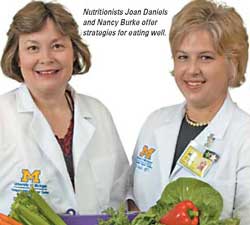Making Every Bite Count
Protein, fat play special role during treatment

By Joan Daniels, R.D., and
Nancy Burke, R.D.
You limit your meat intake to a portion the size of a deck of cards. You choose whole-grain carbohydrates to ensure you're getting the fiber your body needs. You eat lots of fruits and vegetables, especially the green, leafy ones.
That's an excellent plan for most people, but when a cancer diagnosis is involved, "healthy eating" means something different. Your body's needs radically change while it's weathering the effects of treatment and fighting back against your cancer. And the diet we just described sometimes won't meet those needs.
It's important to include enough carbohydrates, protein and fat in your meals to maintain weight during treatments. Cancer causes changes in the way your body uses food for energy. The protein that you'll find in that single chicken breast isn't enough during treatment. Protein is an essential nutrient for healing, tissue maintenance and growth. Your body requires protein to maintain its muscle mass; people who keep their muscle mass generally have fewer side effects during cancer treatment and recover better.
Here are some tips for ways to include healthy protein and fat in your diet. Particularly when side effects are impacting your appetite, it's important to make every bite count.
Tips
- Switch from skim milk to whole milk, if you're struggling with weight loss.
- Melt cheese on sandwiches, stir it into scrambled eggs or grate on top of soups, starches or meats.
- Add cottage or ricotta cheese to fruits and vegetables, egg dishes or desserts.
- Get an extra boost by mixing powdered milk into milkshakes and smoothies.
- Consider drinking nutritional supplements, like Boost or Ensure. Several brands and flavors are available. They also can be mixed with fruits, ice cream and syrups to make milkshakes.
- Eat more eggs. Add extra eggs to pancakes. Sprinkle chopped, hard-boiled eggs over salads. Add hard-cooked egg yolks to sandwich spreads.
- Spread peanut butter and other nutbased spreads on sandwiches, toast and vegetables or swirl them into shakes, smoothies, yogurt and soft ice cream.
- Sprinkle nuts over cereal, salads, vegetables, pancakes or fruit. Think of it as a crunchy topping.
- Add chopped meat to salads, omelets and quiches.
- Eat more beans and tofu. Hummus is high in protein and can be spread on breads and vegetables.
Continue reading the Fall, 2007 issue of Thrive.
Learn more about nutrition and cancer treatment:
Eight Ways to Take Care of Yourself and Your Cancer
